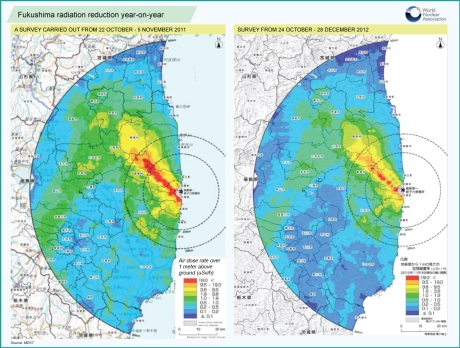The latest aerial survey of the Fukushima region reveals a pattern of contamination significantly reduced in the space of a year by natural processes of radioactive decay and dispersal.
The Ministry of Education, Culture, Sports, Science and Technology (MEXT) released the latest map on 1 March, based on data collected by a survey during October and December last year. Compared to the version from October and November 2011 it shows widespread recolouring, with each colour change indicating a reduction by half in surveyed radiation dose.
Most obvious is a marked reduction in the size of the red portion, which represents high radiation dose rates of over 19.0 microSieverts per hour (uSv/h) - some 166 milliSieverts per year (mSv/y). Anything above 50 mSv/y is characterised as 'difficult to return to' by Japanese authorities.
 |
Click to enlarge this graphic comparing two radiation surveys made one year apart |
The accident at Fukushima Daiichi nuclear power plant in March 2011 released three main radioactive substances: iodine-131, caesium-134 and caesium-137.
Of these, iodine-131 is the quickest to decay, with a half-life of around eight days that means it had contributed virtually nothing to the 2011 map. Of more interest is caesium-134, with a half-life of two years that would show significant reduction in the annual timespan shown by the maps. Further noticeable reductions due to ongoing decay of caesium-134 decay are expected, with these gradually tailing off in years to come.
The long-term issue remains the caesium-137, which has a half-life of about 30 years, and will maintain raised levels of ambient radiation for a significant time. Japanese national and regional governments are tackling this through an extensive clean-up and decontamination program.
Apart from decay, natural processes have also contributed to reducing levels of contamination in the last year. Rainfall moves contamination through river systems to the sea, where strong currents and a powerful dilution effect make radioactivity virtually undetectable even alongside the damaged power plant itself. The region also suffered a Class 4 Typhoon in July last year that will have accelerated dispersal effects.
Researched and written
by World Nuclear News




_30199.jpg)
_72306.jpg)

_49562.jpg)





